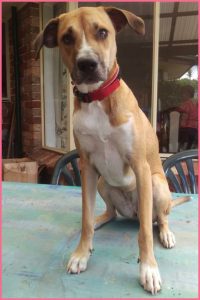Behaviour chains
You may have heard of the concept of “chaining” behaviours to get a certain overall behaviour outcome – a number of individual behaviours or cues are chained together to create a new behaviour. We often work on these purposefully to help with routine or especially in trick training.
For example, you may create a behaviour chain for manners at meal time – place, sit, wait, look, release word. Or you might remember the trick to play “Connect Four” I shared on Facebook a while back – fetch, hold, paw, drop token.
It doesn’t usually matter what order the dog learns the individual behaviours in, but when we start to chain them we purposefully work in order, either backwards or forwards, to create clear links between behaviours. It’s often actually easiest to backwards chain, to start linking from the end goal. And when it starts working for you, it’s easy too see the endless opportunities (and can be easy to try push your dog too fast). Patience is super important.
But guess what? Dogs are smart. They create their own behaviour chains, because remember DOGS DO WHAT WORKS. It’s really easy for us to inadvertently help create behaviour chains, sometimes when we think our communication is clear.
You might remember I mentioned this when I saw Charlie last. Charlie is not allowed on one of the sofas, and has made a really fun game: jump on sofa, non reward marker, asked to get down or on place, reward marker, treat, jump on sofa… ultimately Charlie has worked out he gets rewarded (and remember the dog chooses what’s rewarding) with attention and ultimately a treat as well, for jumping on the sofa and down again. Up, down, reward, up, down, reward, etc…
To stop this usually frustrating behaviour, we need to break the chain. Breaking any of the behaviour links in the chain will weaken the overall behaviour. In Charlie’s case we stopped asking for another behaviour and removed the reward, to break that main link. We also refined communication to weaken the remaining links.
Behaviour chains can totally be used to our advantage to train dogs to do some AMAZING stuff. We just need to remember they are often at play inadvertently, creating frustrating or problem behaviours at home.
Call me, I can help.

Pictured Lucy: jump on table, give paw, humans giggle


